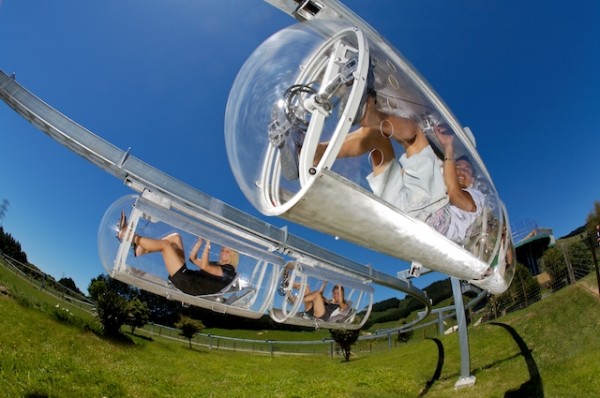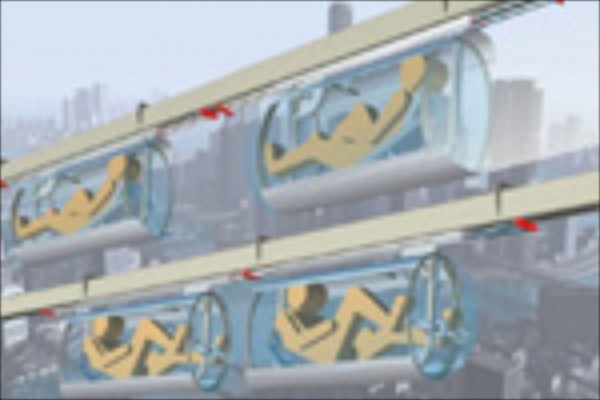Google Funds NZ Monorail
A NZ company’s concept for short to medium distance, urban personal transport, using human-powered vehicles on a monorail has won a NZ $1.36m Google grant.
Google says it is providing the money to fund research and development to test Shweeb’s technology for an urban setting.
It’s original adventure ride is in Rotorua at Agroventures Park and Shweeb says it will soon announce in which city it will test its monorail for public use - but it will be in the Northern Hemisphere.
 Peter Cossey, the firm’s managing director says the funding is in return for a minority shareholding in the company. Any profits Google make from their investment will go to a charitable trust for the betterment of public transportation.
Peter Cossey, the firm’s managing director says the funding is in return for a minority shareholding in the company. Any profits Google make from their investment will go to a charitable trust for the betterment of public transportation.
What is Shweeb?
He calls it a pedal-powered pod attached to an overhead monorail.
“It is an exciting, dynamic ride where riders experience up to 60 degree swings on the curves and soar high and low over the undulating terrain. Riders lie back in a recumbent position for maximum comfort and minimum aerodynamic drag. The hard wheels on the track reduce rolling resistance, and as riders click through the seven gears they get up to high speed (over 40 kph) with little effort. Racing can be either against the clock or another rider. Two Shweeb pods can also be joined together for tandem racing.”
Opened in Rotorua in October 2007, the Shweeb was initially dreamt up by Geoff Barnett, a keen cyclist with an interest in sustainable transport, whilst living in Tokyo a decade ago. Mr. Barnett reasoned that overhead cycle monorails connecting the city’s skyscrapers above the streets of Tokyo had to be a better solution than negotiating traffic jams or building even more roads and expressways.
Returning to his home in Melbourne, he worked on the concept and developed it into a design. Following six years in the refining and testing stages, Mr. Barnett felt that Rotorua, New Zealand, an adventure playground already well known for innovative tourism products, was the perfect place to let the public test ride the concept. So far more than 30,000 riders have given Shweeb a resounding thumbs up. The current world record is 55 seconds for the 600m race.
Mr Cossey says the trial city chosen won’t be in NZ.
“The reason we have chosen to go offshore is really one of necessity,” says Mr. Cossey. “While the prototype has been thoroughly tested in New Zealand; in order to gain creditability in the global marketplace we need to test a transit system in a high density population destination.
“The Northern Hemisphere became the natural choice for us due to the sheer number of people that require transport and also the opportunity to achieve a higher global profile for the future growth of the company. It will also give us the ability to lock ourselves away for 12 months and concentrate on the massive opportunity that Google has laid at our door.”
In 2008 Google launched a project called 10^100 that called for ideas that would change the world by helping as many people as possible. Google evaluated 154,000 ideas submitted by the public and came up with 16 groupings of ideas for the public to vote on.
When ‘Drive innovation in public transportation’ turned out to be one of the five winning ideas, Google set about finding an organisation, company or individual to help bring that idea to life.













6 Comments
Good on them, but it has all the downsides of a system needing a dedicated ovehead track system, plus the downsides of people riding at different speeds conflicting with each other. This has niche and fun potential, but no more than that.
Id like to ask, how an australian that moves his idea to nz sudden becomes a kiwi company?
honestly I think money could have been better spent elsewhere, its a gimic that will never really take off.
Well it’s Google’s money. They have a habit of funding off the wall things, most of them fail but every now and again one explodes out of the blocks. I guess this is one of those things that is most likely going to fail, but you never know until you try it…
Trials are fine, and a good thing. I’ll be interested to see what comes of it.
It will never take off as a form of serious transport but may have a place in the flat part of a city. Wellington railway station around the waterfront to Oriental Bay or Mission Bay to the Western Viaduct via Britomart. Novelty value.
I have an unique invention on urban train different from any existing monorails, suspended train or metro rails in the world. The concept is already patented. This train is superior in safety, ride, cheaper in cost and environmental friendly. see my website www. nextgentrain.com. I am in need of a financial investor for developing and implementing the idea by manufacturing & testing the prototype and marketing thereafter..